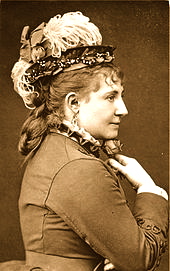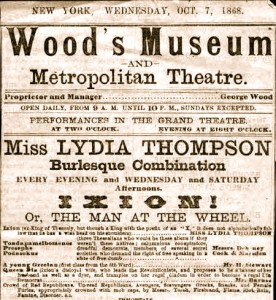Lydia Thompson
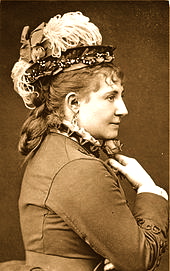
Eliza Weathersby – Lydia Thompson Troupe – British Blondes – Ixion Burlesque
Born in London in 1849, Eliza Weathersby started in burlesque at a young age. Previously of London’s Strand Theater, she came to the USA in early 1869 as part of the Elise Holt Troupe. When Holt got bogged down with show cancellations and money problems, Eliza was easily recruited by Lydia Thompson and became one of the British Blondes. The ‘Blondes’ were still riding high from their massive triumph with the burlesque “Ixion, or the Man at the Wheel”. In Feb. 1869, Lydia took the troupe from Woods Theater to the larger Niblo’s Garden. Eliza played supporting roles, sang naughty songs and was a favorite with the critics. Weathersby became a regular at New York’s Niblo’s Garden, Wallack’s and Woods Theater. When she starred in the burlesque “Evangeline” her career began to take off. Eliza was especially famous in New Orleans where the company had long stays, and where she performed in many burlesques including “Ixion” and “Aladdin” during the 1870’s. The actress married NYC socialite / actor / comedian Nathaniel C. Goodwin. They formed a burlesque company called The Eliza Weathersby Froliques which was active from the late 1870’s till Eliza became ill in 1884. She never recovered, instead her situation got worse. She died in March, 1887 in New York City at the age of 38. Her funeral was attended by the entire performing arts community of New York and was such an event as to be covered in a large article in the New York Times. (which is very interesting for the list of attendees).
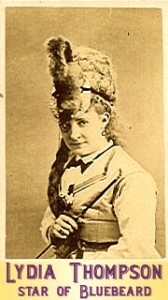 Lydia Thompson in Bluebeard (1872)
Lydia Thompson in Bluebeard (1872)
Lydia Thompson, born Eliza Hodges Thompson (19 February 1838 – 17 November 1908), was an English dancer, comedian, actress and theatrical producer.
After dancing and performing in pantomimes in Britain and then in Europe as a teenager in the 1850’s, she became a leading dancer and actress in burlesques on the London stage. She introduced Victorian burlesque to America with her troupe the “British Blondes”, in 1868, to great acclaim and notoriety. Her career began to decline in the 1890s, but she continued to perform into the early years of the 20th century.
Early Years
Thompson was born in Brydges Street, Covent Garden, London. Her father was Philip Thompson (c.1801–1842) and her mother was Eliza (née Cooper). Her father owned the Sheridan Knowles, a public house. Thompson was the second of three surviving children, including actress Clara T. Bracy. Her father died in 1842, and her mother remarried Edward Hodges. By the age of fourteen, Thompson had left home and joined the stage professionally as a dancer.
In 1852 she became a member of the corps de ballet at Her Majesty’s Theatre. By the following year she was playing a solo role, Little Silverhair, in the pantomime Harlequin and the Three Bears, or, Little Silverhair and the Fairies at the Haymarket Theatre. In 1854 she danced at the old Globe Theatre in Blackfriars Road, in James Planché’s extravaganza, Mr Buckstone’s Voyage Round the Globe. She gained wider public attention later that year at the St James’s Theatre in The Spanish Dancers, a burletta by Thomas Selby, playing the famous dancer Señora Perea Nena. The Times dismissed the piece but praised her performance highly: “It was no burlesque; it was one excellent dancer following in the steps of another, catching the spirit of her model, and rivalling her in the audacity of her execution. The youth and beauty of Miss Thompson gave an additional charm to her Andalusian feats.”
There, she also played in the burlesque Ganem, the Slave of Love, and in the ballet-farce Magic Toys. These performances brought a period of prosperity to what had come to be regarded as one of the unluckiest theatres in London. She also appeared that year in The King’s Rival by Tom Taylor and Charles Reade (J. L. Toole’s first London role), Beauties of the Harem, and, again at the Haymarket, in the title role in the Christmas pantomime Little Bo Peep, or, Harlequin and the Girl who Lost her Sheep. She then returned to complete the season at the St James’s in Cupid’s Ladder and the fairy spectacle, The Swan and Edgar.
Star Dancer
Still a teenager, Thompson then toured through Europe for over three years. She danced in Russia, Germany, Austria, France, Scandinavia and elsewhere, “winning acclaim for the dexterity of her dancing – which included the Highland Fling and Hornpipe – as well as the charms of her person and the vivacity of her character.” She returned to England in the summer of 1859, by which time The Times referred to her as “one of the most eminent of English dancers.”
In the winter season of 1859–60 Thompson danced at the St James’s in several pieces, including Virginius, or, The Trials of a Fond Papa, Lester Buckingham’s burlesque Virginus, Valentine in Magic Toys, Dolly Mayflower in Black-Eyed Susan and Young Norval in the ballet-burlesque My Name is Norval. In 1860–1861, at the Lyceum Theatre, she played again in Magic Toys, as Morgiana in the Savage Club burlesque of The Forty Thieves, in the farce The Middy Asthore, as Fanchette in George Loder’s The Pets of the Parterre (Les Fleurs animées) and as Mephisto in the fairy extravaganza Chrystabelle, or the Rose Without a Thorn. She also played Norah in the first production of Edmund Falconer’s comedy Woman, or, Love Against the World, as Blondinette in Little Red Riding Hood and had a role in the William Brough burlesque of The Colleen Bawn, called The Colleen Bawn Settled at Last.
Thompson married John Christian Tilbury, a riding-master, in 1863, and soon gave birth to a daughter. She returned to the stage in The Alabama at the Drury Lane Theatre. Her husband died fifteen months after their marriage, in a steeplechasing accident in 1864, when he was rolled on by his horse. In the following years, she alternated between London and provincial tours, mixing dancing and acting in plays. In 1864, at the opening of the new Theatre Royal, Birkenhead, managed by Alexander Henderson (1828–1886), she created the title role in a burlesque of Ixion by Francis Burnand. She joined Henderson’s company at Prince of Wales’s Theatre, Liverpool, together with the rising young actors Squire Bancroft, Marie Wilton and Henry Irving. There, she played in Brough’s Ernani (1865), as Max in a burlesque of Weber’s Der Freischütz (1866), as Prince Buttercup in The White Fawn, as Massaroni in the burlesque The Brigand, and as Prince Florizel in another burlesque, Perdita. Thompson excelled as “principal boy” in burlesques: “She was charming to look at, a good singer, a really clever dancer, and the life and soul of the scene while on the stage.” Other successful London runs from 1866–1868 included, at the Drury Lane, Sophonisba in Delibes’ Wanted Husbands For Six (Six Demoiselles à marier) and at the Strand Theatre, Blue-Beard (after Jacques Offenbach’s version) and Darnley in the very successful The Field of the Cloth of Gold.
America and later years
Thompson in Robinson Crusoe, c. 1870 Thompson married Henderson, and the two sailed in August 1868 for America, heading a small theatrical troupe, adapting popular English burlesques for middle-class New York audiences by adding topical and local references and reworking the lyrics of popular songs, while preserving the rhymed couplets and comic puns of the burlesque form.
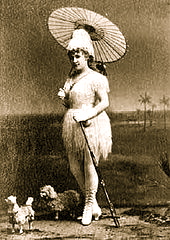 Thompson in Robinson Crusoe, c. 1870
Thompson in Robinson Crusoe, c. 1870
Thompson’s troupe, called the “British Blondes”, was the most popular entertainment in New York during the 1868–1869 theatrical season: “The eccentricities of pantomime and burlesque – with their curious combination of comedy, parody, satire, improvisation, song and dance, variety acts, cross-dressing, extravagant stage effects, risqué jokes and saucy costumes – while familiar enough to British audiences, took New York by storm.” The six-month tour turned into an extremely successful tour of almost six years, and during two subsequent tours, the Blondes drew huge crowds at leading theatres across the US. The troupe launched careers of several actresses, including Markham, Alice Burville and Rose Coghlan, and of comedian Willie Edouin. It also drew fierce criticism from those who felt it transgressed the boundaries of propriety. Reflections on the virtue of her dancers by Wilbur F. Storey, the owner of the Chicago Times, led Thompson and her troupe first to post notices calling Storey “a liar and a coward” and appealing for the sympathy of the people. Then, on 24 February 1870, Thompson, her husband and her colleague, Pauline Markham, horsewhipped Storey at gunpoint, for which they were arrested and fined. Thompson told a reporter that Storey “had called her by the most odious epithet that could be applied to a woman, and she could stand it no longer. She was glad at what she had done.” This resulted in more publicity and popularity for the troupe.[5] Actress Olive Logan protested, “I cannot advise any woman to go upon the stage with the demoralizing influence which seems here to prevail more every day, when its greatest rewards are won by brazen-faced, stained, yellow-haired, padded-limbed creatures, while actresses of the old school – well trained, decent – cannot earn a living.”
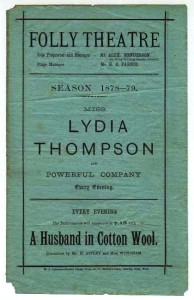 Programme for the Folly Theatre
Programme for the Folly Theatre
Thompson, Henderson and her troupe finally returned to England in 1874, and she resumed her starring roles in London and provincial productions, including H. B. Farnie’s burlesques of Bluebeard (which she had already made a hit in America) and Robinson Crusoe, and Robert Reece’s Carmen, or, Sold for a Song, as well as Piff-Paff (Le Grand Duc de Matapa), Oxygen, The Lady of Lyons, Pluto!, and other burlesques. Henderson purchased the Folly Theatre in 1876, and it became a burlesque house, with Thompson in the lead roles. The first piece was a production of Bluebeard. In the following years, Thompson returned to America several times, where she remained popular. Thompson separated from Herderson, but the two continued to work together into the 1880s. In 1881, after two years in retirement, she returned to the stage as Mrs Kingfisher in the farce Dust.
Thompson returned to New York following the death of Henderson in 1886 and again in the winter seasons of 1888 and 1891. In 1887 she opened at the Royal Strand Theatre, London, under her own management, in Alfred Cellier’s comic opera, The Sultan of Mocha. She next starred in the French vaudeville-opérette Babette (1888, Antonio), but her voice was judged inadequate. After this, her career began to decline. Her last American performances were in 1894 in The Crust of Society in a supporting role. Back in London, George Edwardes cast her briefly in the Edwardian musical comedy An Artist’s Model (1895), but by 1899, she had depleted her funds. A London benefit night was held for her on 2 May 1899 at the Lyceum Theatre, when she performed in The Wedding March by W. S. Gilbert. She also recited a rhymed “farewell address” written for her by Gilbert.[11] Her final performances were in 1904, as the Duchesse du Albuquerque in A Queen’s Romance.
Thompson died in London at the age of 70. She is buried in Kensal Green cemetery. Her daughter, Zeffie Agnes Lydia Tilbury, became an actress known first on the London stage and later for playing wise or evil older characters in films, such as Grandma in The Grapes of Wrath (1940) and Grandma Lester in Tobacco Road (1941).

